So, India does not have a jobs problem. We are generating enough jobs and everybody is living happily ever after.
Or so seems to suggest a new study carried out by Soumya Kanti Ghosh, Chief Economic Adviser at the State Bank of India and Pulak Ghosh, a Professor at IIM Bangalore. The study uses data from Employees Provident Fund Organisation (EPFO).
In a column in The Times of India, the authors write: "Based on all estimates, we believe that 7 million formal jobs are being added to payroll on a yearly basis."
This new study has caught the imagination of the media and the politicians in power and is being flagged all around. If seven million jobs are being created in the formal sector every year, India does not have a jobs problem. The informal sector does not have to register with the EPFO. Informal sector is that part of the economy which is not really monitored by the government and hence, it is not taxed.
The informal sector in India, up until now, has been creating a bulk of the jobs. There are various estimates available on this. Ritika Mankar Mukherjee and Sumit Shekhar of Ambit Capital wrote in a recent research note: "India's informal sector is large and labour-intensive. The informal sector accounts for ~40% of India's GDP and employs close to ~75% of the Indian labour force."
The Institute for Human Development, India Labour and Employment Report, 2014, points out: "An overwhelmingly large percentage of workers (about 92 per cent) are engaged in informal employment and a large majority of them have low earnings with limited or no social protection."
As the Economic Survey of 2015-2016 points out: "The informal sector should... be credited with creating jobs and keeping If unemployment low."If seven million jobs are being created just in the formal sector, imagine what must be happening in the informal sector. Firms and individuals operating in the informal sector, must be falling over one another to recruit people for jobs they have on offer. But is that really happening?
As I have mentioned in the past, 12 to 15 million Indians are entering the workforce every year. And given that seven million jobs are being created just in the formal sector, the individuals currently entering the workforce must be having a ball of a time, with so much to choose from.
Of course, all this goes against what I have been writing all along about India having a huge jobs problem and the fact that India's so called demographic dividend is being destroyed. But it also goes against a lot of other data that is on offer.
Jobs are created when companies invest and expand. Let's first look at the investment to gross domestic product (GDP at constant prices) ratio of the Indian economy. This ratio as I have written in the past has been falling for a while now. Take a look at Figure 1:
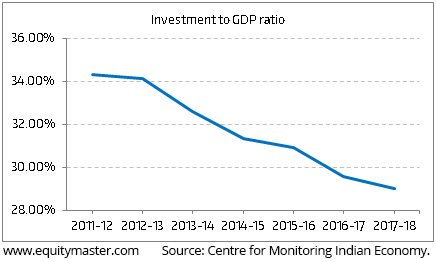 |
As is clear from Figure 1, investment as a part of the overall economy (represented by the GDP) has been falling over the years. How are seven million jobs being created in this scenario? In fact, let's take a look at the incremental investment to incremental GDP ratio, over the years, in Figure 2. This basically plots the ratio of the increase in investment during the course of a year, against the increase in GDP during that year.
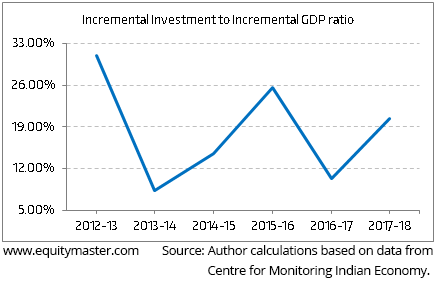 |
The incremental investment to incremental GDP Ratio between 2013-2014 and the current financial year (2017-2018) has varied between 8-25 per cent. India seems to have discovered a new economic model of creating jobs without a pickup in investment, i.e., if seven million jobs are indeed being created every year.
Companies tend to expand when they are unable to meet the demand from their current production capacity. The Reserve Bank of India carries out capacity utilisation surveys of manufacturing firms every three months. The latest survey for the period April to June 2017, found that capacity utilisation stood at 71.2 per cent. In fact, capacity utilisation has varied between 70 and 72 per cent for a while now.
As economist Madan Sabnanvis writes in his new book Economics of India-How to Fool all People for all Times: "The capacity utilisation rate has gotten stuck in the region of 70-72 per cent which means two things: first demand is absent, and second, even if it does increase, production can be scaled up without going in for fresh investment."
The question is how are jobs being created without expansion?
In fact, the data from Centre for Monitoring Indian Economy suggests that new projects announcement in the period of three months ending December 2017, came in at a 13-year low. Take a look at Figure 3.
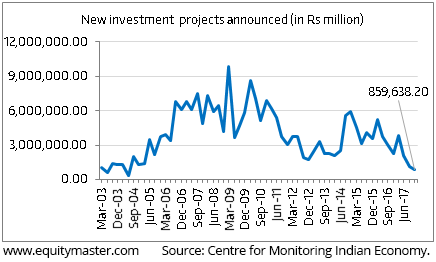 |
The new investment projects announced during the period of three months up to December 2017, were the lowest since the period of three months ending June 2004. This is a clear indication of the fact that the industry is not betting much on India's economic future because if they were they would be expanding at a much faster rate and announcing more investment projects than they currently are.
The industrialists may say good things about India in the public domain and in the media, but they are clearly not betting much of their money on the country. And this brings us back to the question, if the industry is not investing, how are jobs being created?
Let's take a look at the money lent by banks to industry, in Figure 4.
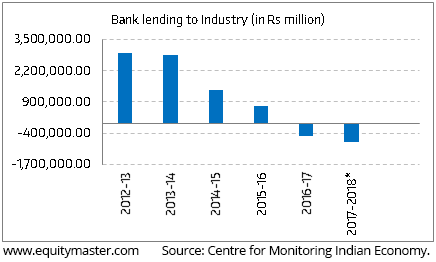 |
The bank lending to industry has been falling over the years. In fact, lately, it has been in negative territory, which means that the overall bank lending to industry has contracted.
This means that on the whole, banks haven't lent a single new rupee to industry, lately. And that is another good example of industries not expanding. This brings us back to the question: how are seven million formal jobs being created then?
One argument that can be offered against Figure 5 is that over the years many corporates haven't been borrowing from banks to meet their funding needs. This is true. But this is largely limited to large corporates. Global experience suggests that jobs are actually created when micro, small and medium enterprises expand, and become bigger. In order to do that, they need to borrow.
How does the scene look when we leave out large corporates? Let's take a look at Figure 5.
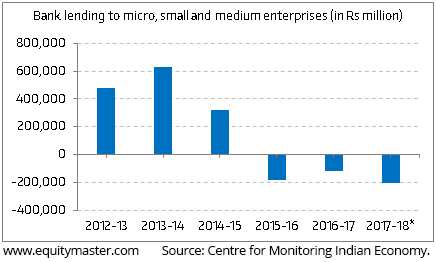 |
Bank lending to micro, small and medium enterprises, has been in negative territory for a while now. This basically means that the overall lending to these enterprises has contracted and not a single new rupee has been lent by banks to these firms. How are these firms investing and expanding and creating jobs?
Of course, manufacturing is not the only sector creating jobs. The services sector creates a huge number of jobs of India. One of the biggest job creators in the services sector are real estate companies, which are currently down in the dumps. The construction sector is also a heavy job creator, but with real estate being the way it is, construction is not doing too well either. The information technology sector is looking to shed jobs at the lower end, with robots taking over. Tourism was never a heavy employer of people, in the formal sector, which is what we are talking about here.
Arvind Panagariya, who was the vice chairman of the NITI Aayog, until August 2017, maintained during his tenure, that India was not creating jobs, because India's entrepreneurs were not investing in labour intensive activities.
In fact, on August 25, 2017, a few days before his tenure ended, Panagariya said: "The major impediment in job creation is that our entrepreneurs simply do not invest in labour intensive activities."
This becomes clear from India's exports. If one looks at labour intensive exports like textiles, electronic goods, gems & jewellery, leather and agriculture, exports have more or less remained flattish over the last few years. (For a detailed exposition on this, you can click here). So, how are jobs being created with exports remaining flat in labour intensive sectors? Further, if we do believe that seven million jobs are being created every year, then was one of the main economic advisers to the prime minister, wrong all along?
Also, if so many jobs are being created, why does India have so much underemployment. Take a look at Table 1.
12 months based on UPSS approach
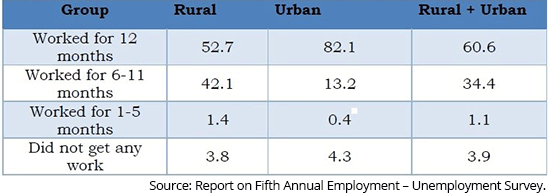 |
What does Table 1 tell us? It tells us that in rural India, only 52.7 per cent of the workforce which was looking for work all through the year, actually found it. 42.1 per cent of the workforce found work for six to 11 months. If there are so many jobs being created, why are these people finding it difficult to find work all through the year, is a question worth asking. Further, if so many people are finding jobs, why has economic growth slowed down over the years. Are these people earning and not spending money? Also, if there are so many jobs going around, why have the land-owning castes across the country been protesting and demanding reservations in government jobs. Is there an explanation for that?
In the end, there is way too much evidence against not enough jobs being created. Trying to brush that aside, on the basis of a shaky study, will do the nation way too much harm. As I keep saying, the first step towards solving a problem is acknowledging that it exists, otherwise there are enough people selling pakodas, bondas, sandwiches, timepass and what not, outside our offices. But that doesn't really solve the problem.
From vivek kaul's dairy

No comments:
Post a Comment